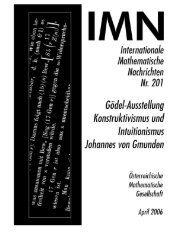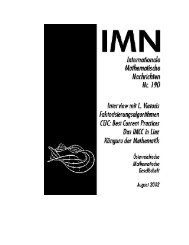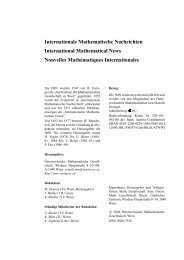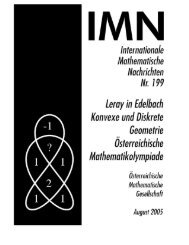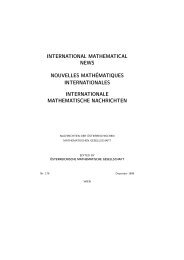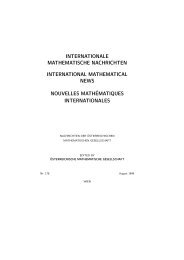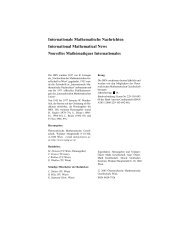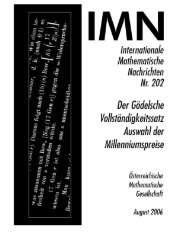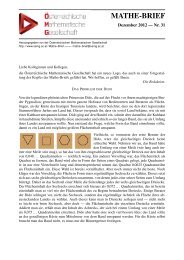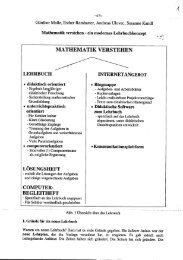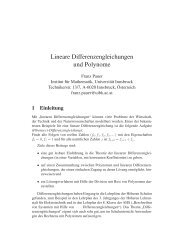218 - Ãsterreichische Mathematische Gesellschaft
218 - Ãsterreichische Mathematische Gesellschaft
218 - Ãsterreichische Mathematische Gesellschaft
Erfolgreiche ePaper selbst erstellen
Machen Sie aus Ihren PDF Publikationen ein blätterbares Flipbook mit unserer einzigartigen Google optimierten e-Paper Software.
hold while in KAM theory only (24) is considered. This yields additional open<br />
questions first formulated in [10]; they will not be discussed in the present paper.<br />
In the next sections we present briefly the only known method – q-class decomposition<br />
– allowing to compute solutions of resonance conditions (23) for a big class<br />
of dispersion functions arising in real life problems.<br />
2 q-class decomposition<br />
The method of q-class decomposition is presented in [10] in 2010 in many details<br />
and generalizations while its theoretical background and some examples have<br />
been first given about twenty years earlier in [7, 8].<br />
We will illustrate the method with one example of resonance conditions which<br />
arises in geophysics. The system of equations<br />
⎧<br />
⎪⎨ (m 2 1 + n2 1 )1/4 + (m 2 2 + n2 2 )1/4 = (m 2 3 + n2 3 )1/4 + (m 2 4 + n2 4 )1/4 ,<br />
m 1 + m 2 = m 3 + m 4 , m j ,n j ∈ N, ∀ j = 1,2,3,4,<br />
(25)<br />
⎪⎩<br />
n 1 + n 2 = n 3 + n 4 ,<br />
describes 4-wave resonance conditions for surface water waves. Here the unknowns<br />
m j ,n j are indexes of Fourier modes A j (T )exp[i(m j x+n j y)−ω(m j ,n j )t],<br />
x,y are space variables, T = t/ε is a time variable, ω(m j ,n j ) = (m 2 j +n2 j )1/4 is the<br />
corresponding dispersion function and A j (T ) is the time-dependent mode amplitude.<br />
Accordingly, the dynamical system (in a somewhat simplified Hamiltonian<br />
form)<br />
{<br />
iȦ 1 = ZA ∗ 2 A 3A 4 , iȦ 2 = ZA ∗ 1 A 3A 4 ,<br />
iȦ 3 = Z ∗ A ∗ 4 A 1A 2 , iȦ 4 = Z ∗ A ∗ 3 A (26)<br />
1A 2 ,<br />
describes the time evolution of resonant modes. The most important fact is that<br />
the coefficients Z = Z(m 1 ,n 1 ,...,m 4 ,n 4 ) are explicit functions of the solutions of<br />
(25). In other words, in order, say, to predict the appearance of freak waves in<br />
the ocean, we must first solve the system of Diophantine equations (25) and than<br />
proceed to solve the system of nonlinear differential equations (26).<br />
In the absence of any methods for simplifying and/or solving analytically the system<br />
(25), our only hope is the trivial but very general problem-solving technique<br />
of brute-force or exhaustive numerical search. In the physically relevant computational<br />
domain |m|,|n| ≤ D = 1000, this direct approach forces us to perform extensive<br />
computations with integers of the order of 10 12 (computational complexity<br />
D 8 ). Such computations for (25) in the substantially smaller domain |m|,|n| ≤ 128<br />
were performed in 2005 at Warwick University by S. Nazarenko’s group. This<br />
took 3 days using a Pentium 4. The reason why this sort of problem is extremely<br />
22



